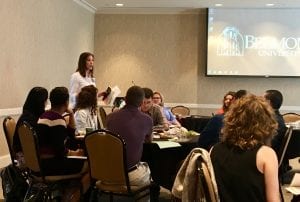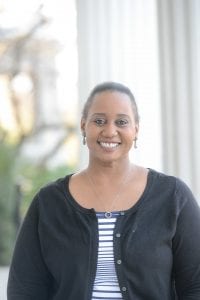Becoming a BANJO Writer
By Anthony Blash (Pharmacy) and Beverly Schneller (English)
In the summer of 2017, Anthony Blash invited a small group of colleagues from across campus to collaborate on an article on the mid-semester peer review of teaching that the Teaching Center coordinates each semester. He had a positive experience with his faculty peer reviewer, Julie Hunt, and he wanted to share what he learned with others. He reached out to Beverly Schneller, Jonathan Thorndike, and Natalie Michaels. Together, the team represented two graduate programs and three undergraduate programs. Anthony, Julie, and Natalie come from disciplines where collaborative writing is common and all had engaged in the peer review process as either a reviewer or a participant. Beverly, though she had not participated in the review process, brought her experience in academic systems and review processes from an institutional perspective. Jonathan, as program director of Honors, conducts peer reviews of the Honors faculty. For the team, collaborating on a writing project allowed us to engage with different perspectives, interpretations, and articulation of the peer review of teaching.
We met weekly across the summer, beginning with brainstorming based on Anthony’s peer review. From our discovery sessions, we identified a few possible themes or theses and then we agreed to write a section in our area of expertise. Anthony recounted his peer review as a participant, Julie as his reviewer, Natalie as both a reviewer and a participant, Jonathan as one who used a complimentary process, while Beverly developed the initial literature review. We all agreed on the value of telling the story of the mid-semester review embedded as part of peer review. We quickly decided we wanted to approach it as a gem in the peer review process which needed more promotion among the faculty.
The meetings were fun and the topics were wide ranging. A couple of meetings in we became the BANJO writing group (an acronym made of our first initials). The more we discussed the topics and refined our thinking, the more we uncovered about our passions for the topic and our earnest desire to invite more faculty to participate in the mid-semester peer review. While at first we were all on separate tasks, within a few weeks we were in sync, starting to finish each other’s sentences! Significantly, when we met to edit the article, we concentrated on tone and word choice more than clarity or content, as we wanted to represent the personal as well as the professional merits of the peer review process to our readers.
The audience we had in mind was our peers, and those who struggle with finding meaning in required student evaluations and departmental peer reviews. We decided to submit to the Currents in Pharmacy Teaching and Learning, because Anthony’s story repeatedly emerged as the hook, giving the emotional connection with readers. We submitted the finished product in November, and after an R and R in January, we are waiting to hear if we made it. We intend to continue generating new research on these topics since our diverse backgrounds and experience converged so harmoniously.
Editor’s Note: For more information on Teaching Center formative reviews and/or for help organizing a writing group, don’t hesitate to contact us.



